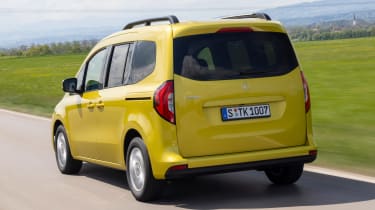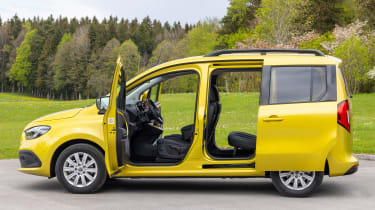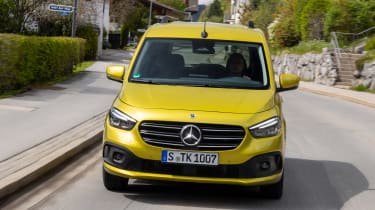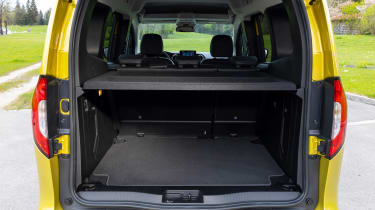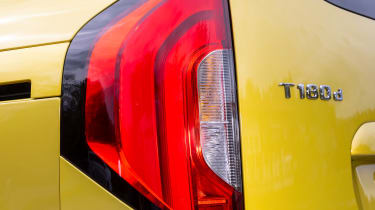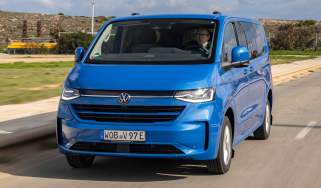Mercedes T-Class MPV review
“The Mercedes T-Class is a posh van-based MPV and should appeal to families who need lots of space”
Pros
- Excellent practicality
- Higher-quality interior than rivals’
- Easy to drive
Cons
- Feels expensive for what it is
- Wayward handling on faster roads
- Small touchscreen
Van-based MPVs are famed for offering huge space at a low price, making them great-value family propositions. So it seems a little strange that the Mercedes T-Class, a Renault Kangoo with premium aspirations, has joined the market, because it’s set to be more expensive than some of its rivals.
But few MPVs are actually cheap these days. There’s the Dacia Jogger with its unbelievably low price, but most of the T-Class’ true rivals, such as the Volkswagen Caddy, Citroen e-Berlingo and Peugeot e-Rifter, are much more expensive. The last two are now solely electric, which has pushed up their prices.
 The best people carriers and MPVs on sale in 2025
The best people carriers and MPVs on sale in 2025
There will be an electric T-Class in time, called the Mercedes EQT, but the availability of diesel engines will broaden its appeal. Not every family car buyer can or wants to plug in to recharge, even if diesel engines are hardly fashionable. A petrol engine is also in the line-up, although it’s not confirmed for the UK yet.
A diesel T-Class won’t be the ideal choice for lots of short journeys around town, so it’s good that it’s refined and quiet at motorway speeds. Mercedes has added plenty of sound deadening and the diesel engine is quiet and smooth if you keep the revs low and leave the automatic gearbox to its own devices.
Some of the Renault influence is clear in the cabin, but overall the Mercedes T-Class does feel more luxurious than any other van-with-windows offering. All the touchpoints feel like they belong in a Mercedes, and material quality is generally good for the upper part of the dashboard. There are some cheaper materials lower down (it is a van, after all) and the touchscreen is on the small side, but overall the interior has more positives than negatives.
The good news continues behind the front seats. There’s plenty of space in the second row, sliding doors for easy access, lots of storage cubbies and a big boot, even if the Citroen e-Berlingo is more useful still. A seven-seat version is set to join the range in 2023.
Time will tell if customers value a more premium take on the van-based MPV formula or whether the T-Class will be overlooked for cheaper alternatives. The brand will be hoping that this car is a bigger hit than the Mercedes X-Class pick-up, which was based on a Nissan Navara but was much more expensive.
MPG, running costs & CO2
Our test car, the more powerful T 180 d diesel option, is capable of achieving 50mpg when equipped with an automatic gearbox. Mercedes hasn’t yet revealed final efficiency figures, nor UK prices for the range. Its CO2 emissions of 147-154g/km aren’t particularly noteworthy; a diesel T-Class won’t be a particularly appealing choice to tax-conscious company-car drivers.
On the other hand, the Mercedes EQT electric version, coming later on, could be. We don’t have range figures, but the Peugeot e-Rifter and Vauxhall Combo-e Life officially manage 170 miles on a charge. The Renault Kangoo ZE, which shares its underpinnings with the EQT, manages 159 miles.
Mercedes offers a three-year, unlimited-mileage warranty, and routine maintenance and servicing should be taken care of by a service plan that allows you to pay monthly.
Engines, drive & performance
We wouldn’t blame you if you skip past this section and go straight to our verdict on the T-Class’ interior and practicality. If you’re looking at MPVs, chances are you’re not really bothered about an exciting driving experience. And neither should you be, because the Mercedes T-Class doesn’t offer such frivolity.
UK buyers may be faced with a diesel-only line-up, at least until the electric Mercedes EQT variant goes on sale. The 1.5-litre diesel engine, borrowed from Nissan and Renault, comes with either 94 or 114bhp, and we tested the latter hooked up to a seven-speed automatic gearbox. It’s not quick, taking 13.2 seconds to reach 62mph from a standstill (13.6 with a manual gearbox).
The engine noise rises above 2,000rpm but acceleration doesn’t markedly improve, so we’d try to keep a relaxed pace and let the automatic gearbox change up early. It’s quite quick to change down when required, and this gearbox makes sense in a car like this.
In town, the T-Class is a doddle to drive thanks to its super-light steering and impressive all-round visibility. At higher speeds, it feels a little top-heavy and wayward, with a fair amount of body roll and vague steering. The suspension highlights that this is one of Mercedes’ cheaper models, as it sometimes gets unsettled over bumps, but the ride should improve with more people or luggage on board.
Interior & comfort
Some of the switchgear in the T-Class is shared with cars such as the Dacia Sandero and Renault Clio, but none of it looks incongruous next to the Mercedes steering wheel. All versions come with a touchscreen, which is small at seven inches and has a chunky plastic surround that makes it look a little dated. But as it runs Mercedes’ MBUX infotainment system, it works very well.
Even if the climate dials come from cheaper cars, they’re a welcome addition; some rivals force you to use touch-sensitive panels or go through menus on the touchscreen. Elsewhere, the quality of materials used is slightly higher than what you’d typically find in this class. There are some hard, cheap plastics, but the bits you’ll interact with all feel like they belong in a Mercedes.
Practicality & boot space
For now, the Mercedes T-Class comes with only five seats; a long-wheelbase seven-seat version is in the pipeline. Even the five-seat model should suffice for many families. Its sliding doors make access easy, especially in tight car parks, and the rear seats are spacious. If you’re a particularly tall family, those in the back seats might not have quite enough knee room, but there’ll be no complaints when it comes to headroom.
Storage up-front is very good, with van-inspired touches like an overhead shelf and a deep glovebox, while the boot measures 520 litres with the seats up and a huge 2,127 litres with them folded.
The Peugeot e-Rifter is even more practical, though. It has more storage areas, a bigger boot (775 litres up to 3,000 litres, in fact), an opening tailgate window and three ISOFIX child-seat points across the rear bench. The Mercedes has two as standard, but a booster seat does fit between two child seats.
Reliability & safety
The challenge for the T-Class engineers is how to make all the Mercedes and Renault parts work together. This mix of components makes it tricky to suggest how reliable the T-Class will be, although that it’s based on vans (the Mercedes Citan and Renault Kangoo) should give peace of mind. Vans need to be reliable to stand a chance of being popular with business users.
Mercedes came 13th out of 29 brands in our 2021 Driver Power owner satisfaction survey, above BMW, Volkswagen and Audi, but slipped to 23rd in 2022, sending it to the back of the pack. Renault, meanwhile, finished 24th, and the percentage of owners who experienced a fault in the first year was 27.3% for Mercedes and 22.5% for Renault.
The T-Class has a reassuring five-star Euro NCAP rating, which was credited to its active safety features and a new centre airbag that helps protect occupants in a side-impact. Mercedes has posted a string of five-star scores recently, but Renault has suffered some lower-than-expected results.


